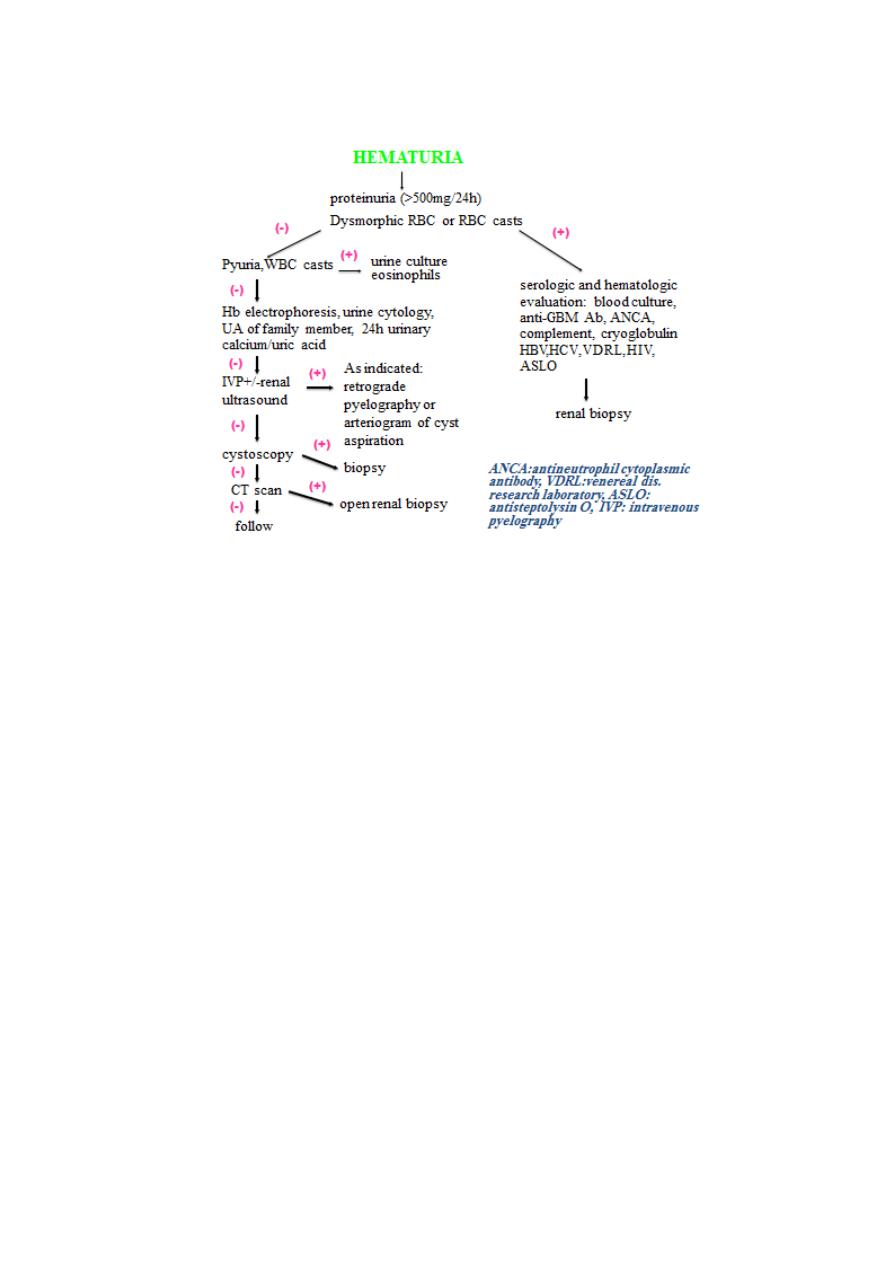
1
4th stage
جراحة بولية
Lec-2
د.احمد
7/10/2015
Hematuria
DEFINITION
More than three red blood cells are found in
centrifuged urine per high-power field microscopy
( > 3 RBC/HP).
Normal urine:
no red blood cell or less than three red blood cell
According to the amount of RBC in the urine, hematuria can be classified as:
microscopic hematuria:
normal colour with eyes
gross hematuria:
tea-colored, cola-colored, pink or
even red
ETIOLOGY
Diseases of the urinary system—the most common cause
Vascular
arteriovenous malformation
arterial emboli or thrombosis
arteriovenous fistular
nutcracker syndrome
renal vein thrombosis
loin-pain hematuria syndrom
cogulation abnormality
excessive anticogulation
Glomerular
IgA nehropathy
thin basement membrane disease (incl.Alport syndrome)
other causes of primary and secondary glomerulonephritis
Interstitial
allergic interstitial nephritis
analgesic nephropathy
renal cystic diseases
acute pyelonephritis
tuberculosis
renal allograft rejection
Uroepithelium
malignancy
vigorous excise
trauma
papillary necrosis
cystitis/urethritis/prostatitis(usually caused by infection)
parasitic diseases (e.g. schistosomiasis)

2
nephrolithiasis or bladder calculi
Multiple sites or source unknown
hypercalciuria
hyperuricosuria
System disorders
Hematological disorders
plastic anemia leukemia
al lergic purpura hemophilia
IT P (idiopathy thrombocytopenic purpura)
Infection
infective endocarditis
septicemia
epidemic hemorrhagic fever (Hantaan virus)
scarlet fever (
-hemolytic streptococcus)
leptospirosis (leptospire)
filariasis (Wuchereria bancrofti, Brugia malayi)
Connective tissue diseases
systemic lupus erythematosus (SLE)
polyarteritis nodosa
Cariovascular diseases
hypertensive nephropathy
chronic heart failure
renal artery sclerosis
Endocrine and metabolism diseases
gout
diabetes mellitus
Diseases of adjacent organs to urinary tract
appendicitis salpingitis
carcinoma of the rectum
carcinoma of the colon
uterocervical cancer
Drug and chemical agents
sulfanilamides anticogulation
cyclophosphamide mannitol
miscellaneous
exercise “idopathic” hematuria
CLINICAL FEATURE
Color
depends on the amount of red blood cell in the urine and the pH (see slide 4)
normal: light yellow, pH 6.5
pH
acidic: more darker (brown or black)
alkaline: red
DIFFERENTIAL DIAGNOSIS
Polluted urine: menstruation
Drug and food: phenosulfonphtha lein (PSP),uric acid, vegetable
Porphyrism: porphyrin in urine (+)
Hemoglobinuria
hemolysis

3
soy-like, very few RBC under the microscopy
occult blood test (+)
HEMOGLOBINURIA
RBC abnormality
Defects of RBC membrane structure and function (hereditary spherocytosis)
Deficiency of enzymes (favism)
Hemoglobinopathy (thalassemia)
PNH
Mechanical factor (artificial heart valve), infection
or mismatched blood transfusion
LABORATORY TESTS
Three-glass test
Method: collecting the three stages of urine of
a patient during micturition
Result:
the initial specimen containing RBC—the urethra
the last specimen containing RBC—the bladder
neck and trianglar area, posturethra
all the specimens containing RBC—upper urinary
tract, bladder
Phase-contrast microscopy
to distinguish glomerular from post glomerular bleeding
•
post glomerular bleeding: normal size and shape of RBC
•
glomerular bleeding: dysmorphic RBC (acanthocyte)
EXAMPLE OF PHASE-CONTRAST MICROSCOPY TEST (non-glomerlar)
EXAMPLE OF PHASE-CONTRAST MICROSCOPY TEST (glomerlar)
ACCOMPANIED SYMPTOMS
Hematuria with renal colic
renal stone, ureter stone
if with dysuria, miction pause or staining to void: bladder or urethra stone
Hematuria with urinary frequency,urgency and dysuria
bladder or lower urinary tract (tuberculosis or tumor)
if accompanied by high spiking fever, chill and loin pain: pyelonephritis
Hematuria with edema and hypertension
glomerulonephritis
hypertensive nephropathy
Hematuria with mass in the kidney
neoplasm
hereditary polycystic kidney
Hematuria with hemorrhage in skin and mucosa
hematological disorders
infectious diseases

4
Hematuria with chyluria
Filariasis
